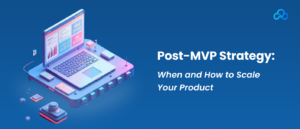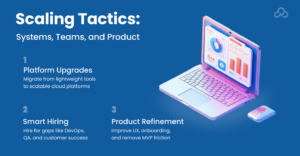Introduction

A successful product MVP example launch feels like a finish line, but it’s actually just the first checkpoint. What comes next determines whether your product becomes sustainable or simply fizzles out. Post-MVP is where many early-stage products stumble, not because of a flawed idea, but due to poor scaling decisions. This phase calls for more than ambition. It requires strategy, timing, and readiness. That’s why custom MVP software development plays such a pivotal role in preparing your product for scale. A generic setup might get you through validation, but it rarely supports long-term growth.
In this guide, we’ll unpack the signals that show you’re ready to grow. We’ll also walk through what to do first, what to avoid, and how MVP development for startups evolves once the initial market signal is clear.
The MVP Is Working, Now What?
Your MVP is functional. Real users are interacting with it. Maybe they’re even paying for it. But before you throw resources into scaling, pause. You need to ask: what does “working” really mean?
Success in the MVP phase isn’t defined by launch alone. It’s about validation, did users find value in what you delivered? Did it solve a real problem? A robust software MVP should be focused, lean, and built to learn. But now it’s time to confirm that what you’ve learned is reliable at a larger scale.
Some signals that you’re heading in the right direction:
-
Consistent user engagement over several weeks
-
Positive qualitative feedback and recurring usage
-
Organic user growth or referrals
Think of a product MVP example: a small project management tool launched to a niche group of freelancers. If they continue using it daily after a month, and start inviting collaborators, that’s not just traction. That’s signal.
This is the moment where agile MVP practices come full circle. You’ve validated the core. Now the question is: can the system handle more users, and should you evolve the architecture?
Scaling Checklist: What Needs to Be in Place
Scaling a product too early can collapse its potential. But waiting too long could mean missing your window of opportunity. So what should be true before making the leap?
-
A proven core experience
Your product MVP example needs to have clear evidence of value. If users struggle to find it, scaling only compounds confusion. -
Technical readiness
Early MVPs are often built with speed in mind, quick frameworks, limited integrations, or no-code platforms. But as your audience grows, performance, reliability, and extensibility become vital. This is where custom MVP software development offers real advantages. It lets you optimize architecture for scale instead of patching things later. -
Stable infrastructure
Make sure your servers, APIs, and third-party dependencies can handle 10x traffic. If your system can’t absorb growth smoothly, you’ll bleed users before you ever grow. -
Team readiness
During MVP development for startups, it’s normal for one or two people to wear multiple hats. But scaling requires role clarity, especially in support, engineering, product, and growth. -
Data-driven decision-making
Have clear KPIs and feedback loops in place. Use data to guide roadmap decisions rather than gut instinct. -
Scalable development process
Your early sprint cycles may have worked when priorities changed hourly. Now you need a sustainable process rooted in agile MVP discipline, with prioritization, sprint planning, retrospectives, and ownership.
Scaling Tactics: Systems, Teams, and Product
Once the basics are in place, it’s time to think tactically. Scaling isn’t just about pushing traffic, it’s about reinforcing infrastructure, empowering people, and evolving the product.
-
Platform upgrades: Moving from lightweight stacks to scalable solutions (e.g., migrating from Firebase to AWS or GCP). This is where custom MVP software development gives you tighter control.
-
Hiring strategy: Expand with purpose. Don’t just hire for volume, hire for known gaps. That might mean DevOps, QA automation, or customer success.
-
Product refinement: Design matters more now. The rough edges acceptable in an MVP won’t fly with paying customers. Invest in UX, polish onboarding, and remove friction.
Case Studies: What Scaling Looks Like in Practice
Case Study 1: A B2B SaaS startup used an MVP to attract 50 early customers. The feedback loop confirmed the product solved a real workflow problem. Before scaling, they rebuilt using a custom MVP software development approach and cut support tickets in half. Within 6 months, MRR tripled.
Case Study 2: A mobile fitness app grew from a software MVP built in no-code. After hitting 5,000 MAUs, they invested in full-stack engineering. Their retention improved by 40% after redesigning user onboarding using agile MVP feedback loops.
These stories aren’t outliers, they’re reminders that MVPs evolve best when they’re rooted in user need and scaled with discipline.
Custom MVP Software Development and Infrastructure Readiness
Here’s the truth: out-of-the-box tools and plug-ins get you to MVP. But they rarely take you past it. Scaling requires adaptability, and custom MVP software development is how you build it.
It’s about:
-
Clean codebases that can be maintained and audited
-
Systems that can integrate with CRMs, data lakes, analytics pipelines
-
APIs that let you move fast without re-platforming
If growth is the goal, flexibility is the tool. Customization offers the control, security, and performance that off-the-shelf won’t.
Technical FAQs
Q1: How long should we stay in MVP mode before scaling?
There’s no set time. But if your software MVP shows repeat usage, organic referrals, and high retention, it’s time to consider scale.
Q2: What’s the difference between a software MVP and a scalable product?
A software MVP is built for learning. A scalable product is built for longevity. The former is fast and lean; the latter is stable and extensible.
Q3: Is agile MVP methodology still useful after validation?
Yes. In fact, it becomes more critical. Scaling adds complexity, and agile MVP cycles help break that complexity into manageable, user-validated steps.
Q4: Do I need a custom MVP software development team to scale?
If you’re hitting bottlenecks with performance or integration, then yes. Custom development gives you the structure needed for scale, without the technical debt.
Visual: Scale Readiness Checklist Table
|
Area |
MVP State |
Scale-Ready State |
|
Product |
Core feature live |
Roadmap validated by feedback |
|
Users |
Early adopters |
Consistent, growing user base |
|
Tech Stack |
No-code / lightweight stack |
Custom MVP architecture |
|
Team |
Founders + 1-2 engineers |
Dedicated support and dev leads |
|
Metrics |
Feature usage + feedback |
Retention, CAC, LTV clarity |
Scale With Precision, Not Pressure
It’s tempting to scale once an MVP shows early traction. A few paying customers, some media coverage, maybe even a round of investor interest. But sustainable growth isn’t born from momentum alone, it demands discipline, structure, and deep understanding of what’s working and why.
Scaling too early is like pouring gasoline on an engine that hasn’t been tuned. Sure, it might run faster, for a moment. But if the infrastructure, team, and product aren’t prepared, it’ll sputter out or break down entirely. That’s the difference between rapid expansion and resilient growth.
Your MVP gave you signal. It proved that people are willing to engage, maybe even pay. But now you need to take that raw insight and build around it. Whether it’s refining your stack, maturing your workflows, or hardening your backend systems, this is where custom MVP software development becomes more than a convenience. It becomes a requirement.
With tailored architecture, optimized code, and scalable APIs, custom development empowers you to respond quickly without sacrificing performance or long-term maintainability. It’s the foundation on which robust, flexible, user-centered products are built.
So build what’s working. Double down on what users value. Drop the features that distract. Scale the experience, not just the tech. And above all, remember: even when the MVP phase ends, the learning never should.
Do you like to read more educational content? Read our blogs at Cloudastra Technologies or contact us for business enquiry at Cloudastra Contact Us
